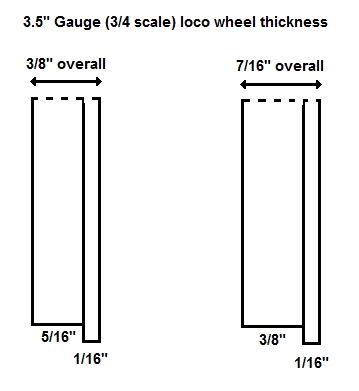syrtismajor
Junior Member
- Joined
- Feb 15, 2010
- Messages
- 50
- Reaction score
- 21
Hello all!
This is sort of a newbie question where I have had various answers from different people who all seem to have varying opinions.
Basically it is about the thickness of locomotive wheels, specifically when used on 3.5" gauge track (3/4 scale)
Some loco designers seem to favour a thicker wheel (3/8" tread with a 1/16" flange) while others seem to favour thinner wheels (5/16" tread with a 1/16" flange). Is this just down to the opinion of the builder or is there a genuine reason for this difference?
The thicker wheel makes sense to me for long duration of use whereas the thinner (or more finescale) wheel wouldn't have the same durability. This however is the squashed by the angle most wheel treads are cut so the are not at 90degree angle to the face
Anyway, I hope the following crap-o-cad drawing will make sense:

The main reason I ask is that I am in the process of trying to design my own live steam 3.5" gauge locomotive. Most of it I think I have pretty much got sorted (including the layout of the valve gear). The main two things I need finalising are the thickness of the wheels and the design of the boiler (that will be 'borrowed' from a published plan though). This will be the next project after my 'Virginia' is completed...
Any help or suggestions would be greatly appreciated!
This is sort of a newbie question where I have had various answers from different people who all seem to have varying opinions.
Basically it is about the thickness of locomotive wheels, specifically when used on 3.5" gauge track (3/4 scale)
Some loco designers seem to favour a thicker wheel (3/8" tread with a 1/16" flange) while others seem to favour thinner wheels (5/16" tread with a 1/16" flange). Is this just down to the opinion of the builder or is there a genuine reason for this difference?
The thicker wheel makes sense to me for long duration of use whereas the thinner (or more finescale) wheel wouldn't have the same durability. This however is the squashed by the angle most wheel treads are cut so the are not at 90degree angle to the face
Anyway, I hope the following crap-o-cad drawing will make sense:

The main reason I ask is that I am in the process of trying to design my own live steam 3.5" gauge locomotive. Most of it I think I have pretty much got sorted (including the layout of the valve gear). The main two things I need finalising are the thickness of the wheels and the design of the boiler (that will be 'borrowed' from a published plan though). This will be the next project after my 'Virginia' is completed...
Any help or suggestions would be greatly appreciated!































































